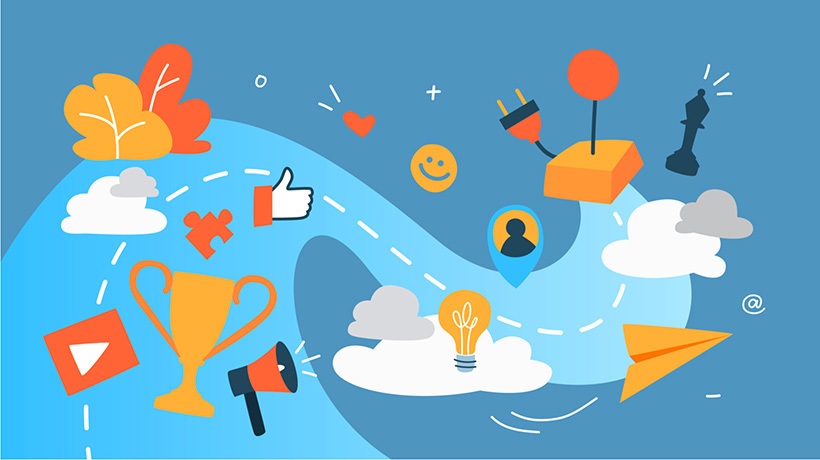Gamification Offers A New Kind Of Interactive Learning
Gamification helps the willingness of a student to study and learn in a more enjoyable and interactive way. 67% of students reported that a gamified course was more motivating than their traditional curriculum.
Essentially, gamification is the application of game design and mechanics in non-game settings and contexts. This includes a wide variety of methods such as leaderboards, point systems, reward systems, and more.
Gamification Aids Education
A major hurdle is getting personally interested in learning. Many of us are not self-motivated enough to study just for the satisfaction of gaining knowledge and a good grade.
Gamification offers additional means of motivation. It improves engagement by creating an interactive and fun experience. It can give students personal ownership of their learning, the freedom to try and fail until they succeed without major consequence, the breakdown of tasks and learning into manageable "portions," and it also makes learning visible.
Gamification allows pacing, which is important when learning, allowing students to process information in a comfortable way.
Gamification Vs. Traditional Learning
Game-based learning has become a more effective means of learning when compared to traditional methods. Gamification increases up to 20% of a student’s self-confidence. It increases the retention of learned knowledge by 90%, and it increases the number of completed tasks by 300%. Game-based learning also improves conceptual knowledge by 11% and practical knowledge by 20%.
Why Is Gamification In Learning So Effective?
Implementing gamification into education creates a fun, interactive way to inspire participation.
1. Takes "Learning" Out Of The Learning Process
Games are a natural way of learning that we have been experiencing since childhood. They provide means of gaining knowledge through fun and simpler means rather than simply reading textbooks and listening to lectures. Learning becomes inspiring and engaging. After all, who doesn’t like to play some form of a game?
2. Creates Competitive Motivation
Having challenges to overcome gives you a reason to learn. More importantly, learning becomes easier since it’s interactive and fun throughout the process, and results are visible.
3. Helps Release Hormones That Positively Impact Our Overall Being
Different studies show that neurotransmitters (chemicals used to send signals to the brain) are released when gamification is done well. In turn, motivation increases, we see an increase in grades, and engagement also increases, making the learning process more successful.
- Dopamine is a chemical that is released when you are surprised. It is also a key part of learning associations.
- Oxytocin is another chemical involved in the effectiveness of gamification. This chemical helps us develop connections with those we meet, even if they’re not real people. This is why gaming is so narrative dense.
- Serotonin levels are affected by how important we feel and they are basically the difference between our feelings of unhappiness or anxiousness and happiness or content. Participating in games gives us the opportunity to feel important, which in turn increases serotonin.
- Endorphins give you the feeling of euphoria and are released whenever we achieve something.
Types Of Gamification In Education
Gamification, as it relates to education, is often expressed in 4 ways: cosmetic/visual enhancement, accessory, integrated, or through making the learning process a game.
1. Cosmetic/Visual Enhancement
The cosmetic type of gamification is typically where you would add game visuals and design elements to make your curriculum come to life. This could be accomplished in the form of a simple visual roadmap of the curriculum or learning program. While the content of the program will remain the same, the new visuals can help motivate learners.
2. Accessory
Gamification as an accessory is where we start to implement a system of accomplishing milestones and receiving rewards to mark progress. This can be done in the form of badges, points, or leaderboards. Implementing this strategy changes little about the actual curriculum in place, but just adjusts the structure a bit, breaking it down into milestones for learners to achieve and be rewarded for.
3. Integrated
Integrated applications of gamification into education is where gaming mechanics become a central part of the learning experience. Instead of having just an added element to an already built program, the entire original program finds ways to incorporate game elements to create a more balanced experience.
4. Making Learning A Game
Finally, making the learning process a game is where the entire program or curriculum from the ground up is an entire game. The learners are aware of the game and are only really actively aware of learning when they are somehow tested.
Wrap up
Gamification provides students with an alternative means of learning to the traditional idea of learning and study. Instead of fearing the task of learning new things, gamification encourages students by providing additional motivation and making learning a fun activity. This can be especially powerful for people who are not naturally able to learn effectively through traditional methods. And gamification practices can also be used by educators to bring fun into the learning experience.
As we have seen, gamification is the future, it’s more effective than regular learning. This is an exciting way to gain new skills, all while doing something you enjoy.
